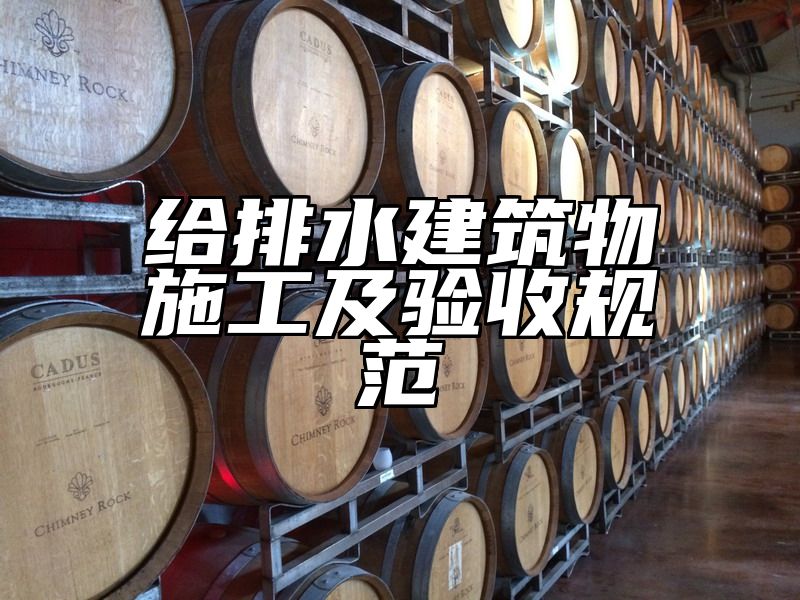

给排水建筑物施工及验收规范
Give us clean water, remove our waste: Design and Construction Standards of Plumbing System
The plumbing system is an essential part of a building's infrastructure, responsible for providing clean water and removing waste. In China, the standards for plumbing system construction and acceptance have been established to ensure the safe and efficient operation of plumbing systems in buildings.
Standards for plumbing system design
The design standards for plumbing systems mainly include four aspects:
1. Hygienic requirements for drinking water
Drinking water must meet standard drinking water requirements, which should be free of any harmful substances. The hygienic requirements of water quality must be considered, and the water supply must be designed to avoid any potential health hazards.
2. Water pressure requirements:
The water pressure should be sufficient to meet the requirements of the plumbing system design, and the equipment used must be able to withstand the maximum working pressure of the water supply system.
3. Drainage requirements:
Drainage should be smooth, free from blockages and leaks, and adhere to environmental protection requirements. The design must consider total sewage flow, pipeline gradient, pipeline materials, and the location of ventilation pipes.
4. Fire protection requirements:
The plumbing system should be designed with fire protection requirements in mind. This includes the installation of water supply and drainage equipment that can withstand high temperatures, as well as the installation of independent water supply and drainage systems for fire protection purposes.
Standards for plumbing system construction
The construction of plumbing systems must be supervised and implemented in accordance with relevant standards and regulations. The construction standards mainly include three aspects:
1. Construction quality standards:
The plumbing system construction must be carried out in strict accordance with the design requirements and specifications. The materials used should meet national standards, and the pipelines should be installed correctly, avoiding any blockages and leaks.
2. Construction safety standards:
Construction safety measures must be taken into account in plumbing system construction, including the use of personal protective equipment, and the provision of fire protection and safety facilities. Safety training is required for those involved in plumbing system construction.
3. Construction supervision standards:
The construction supervision must be implemented in strict accordance with the relevant regulations. The supervision of water supply and drainage pipelines must be carried out, including their route, gradient, height, and spacing. Materials used in the construction of the plumbing system should be inspected regularly, and any substandard materials must be replaced in a timely manner.
Additional Information
The following are some common issues in plumbing system design and construction:

1. How to choose pipeline materials?
Pipeline materials should be selected according to the water quality and the characteristics of the building structure. Generally speaking, plastic pipes are commonly used in buildings, while steel and copper pipes are used in larger commercial and public buildings.
2. What are the requirements for ventilation pipes?
Ventilation pipes are essential for sewage discharge, and must be constructed as straight pipes, extending to the roof. The diameter of the ventilation pipe should be based on the diameter of the sewer pipe. The maximum height of the ventilation pipe can be determined based on local regulations.
3. What measures can be taken to prevent pipeline blockages?
Preventing pipeline blockages is important. Regular cleaning and maintenance are necessary to ensure the smooth operation of the plumbing system. Drainage devices, such as hair traps, can be installed to prevent debris from entering the pipeline. Using high-quality materials when constructing the plumbing system can also help to reduce the incidence of blockages.
4. What safety measures can be taken for the construction processing of the sewer pipeline?
During the construction of sewage pipelines, the workers should wear protective clothing and employ adequate ventilation while in areas with high levels of toxic gas. If necessary, a blower can be used to maintain the ambient atmosphere. Workers should avoid smoking and open flames. In areas where inflammable substances are stored, workers must take appropriate measures and carry out construction with caution.
5. How to ensure the maintenance and management of the plumbing system in the future?
To ensure the smooth operation of the plumbing system in the long term, routine inspection and maintenance should be carried out, including the detection and renewal of aging equipment and pipelines. A record of the maintenance and inspection process should be recorded, and any problems with the system must be addressed immediately.
By following the above standards and guidelines, the design, construction, and maintenance of plumbing systems can be carried out safely and efficiently, providing clean water and removing waste to meet the needs of modern society.






